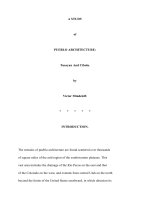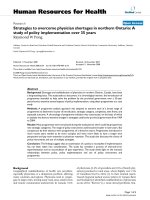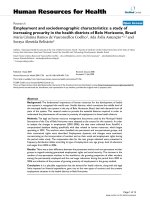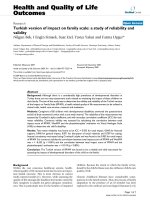A study of tensile strength of fractured rock mass by phase field method in DEAL.II with local refinement technique
Bạn đang xem bản rút gọn của tài liệu. Xem và tải ngay bản đầy đủ của tài liệu tại đây (402.44 KB, 9 trang )
Transport and Communications Science Journal, Vol. 71, Issue 7 (09/2020), 737-745
Transport and Communications Science Journal
A STUDY OF TENSILE STRENGTH OF FRACTURED ROCK
MASS BY PHASE FIELD METHOD IN DEAL.II WITH LOCAL
REFINEMENT TECHNIQUE
Hong Lam Dang
University of Transport and Communications, No 3 Cau Giay Street, Hanoi, Vietnam
ARTICLE INFO
TYPE: Research Article
Received: 14/8/2020
Revised: 15/9/2020
Accepted: 15/9/2020
Published online: 30/9/2020
/>*
Corresponding author
Email:
Abstract. Cracking propagation in elastic and porous media is still challenge topics in
mechanical, energy, and environmental engineering. In this paper, the phase field method will
be used to model the cracking propagation at the small scale for elastic media. This method is
doing well in DEAL.II with the help of local refinement technique which allows studying the
tensile strength of fractured rock mass behavior without prior knowledge of cracking
propagation path and reduction of computational consumption. This implementation is
applied to model a fractured rock mass in which a plenty of explicit fractures are distributed
though total energy released by Griffith's criterion. Through these applications, we
demonstrate and highlight the performance of the phase field method with local refinement
technique in modeling crack propagation as well as investigate the tensile strength of
fractured rock mass dependency its crack orientation
Keywords: fracture propagation, fractured rock mass, explicit modeling of fractures, DEAL.II, phase
field method
© 2020 University of Transport and Communications
1. INTRODUCTION
Cracking propagation in elastic and porous media is still challenge topics in mechanical,
energy, and environmental engineering. Many approaches for brittle fracture have gained
increased interest from studies such as phase-field techniques in [1-5] and extended finite
element method (XFEM) in [6]. For assembling cracks / fractures into porous media,
737
Transport and Communications Science Journal, Vol. 71, Issue 7 (09/2020), 737-745
numerical approach can be applied by incorporated with one of some techniques such as
cracks are introduced explicitly, interface elements are used for crack elements or XFEM in
which the requirement of cracking trend prior to calculation [6].
Distinguishing to the discontinuity explicit model (like in the XFEM [6]), the lowerdimensional crack surface is approximated by a phase-field function which introduces a
diffusive transition zone (brittle or mushy-zone are also common expressions depending on
the discipline) between the broken and the unbroken material. In this study, introducing
cracks or fractures explicitly is applied. This technique is positive in case grid refinements
surrounding cracks do well in DEAL.II [7-10]. For more precise, the theory of cracking
propagation in mechanical phenomena was treated largely in the past with a plural of
methods. With phase field method based on the Griffith energy [11] and Francfort-Marigo
functional [12], Heister et al [1] implemented a treatment of two variables, displacement for
linear mechanical behavior and phase field for cracking propagation by fully coupling. The
phase field method has an advantage of finding cracking path without understanding of
cracking trend during process and can be applied in numerous cracks. However, phase field
value of interface domain between cracked area and non-cracked domain is difficult to
determine. Base on a series of reports of using phase field method to model cracking
propagation supplied by the Institute for Computational Engineering and Sciences (ICES) [15], the paper studies the tensile strength of fractured rock mass in which a plenty of cracks are
distributed on the sample.
2. PHASE FILED METHOD IN DEAL.II
The mathematical model in cracking propagation involves the coupling of two variables:
(a) the linear elasticity system, and (b) the elliptic variational inequality for the phase field
variable. Following Griffith's criterion [11] and Francfort-Marigo functional [12] we suppose
that crack propagation occurs when the elastic energy restitution rate reaches its critical value
Gc. If τ is the traction force applied at the part of the boundary N and it can associate to the
crack C, body force F, the following total energy E (u, C ) is written as below [1-4]
E (u, C ) =
1
( (u), e(u) )\C − ( , u ) N + ( F , divu )\C + Gc H d −1 (C )
2
(1)
We introduce the time-dependent crack phase-field φ, defined on Ωx(0; T). The
regularized crack functional ( ) reads
( ) =
1
2
1 − +
2
2
2
(2)
Note is the aspect ratio of crack → 0 . Thus, we replace the total energy (1) by (2) and
neglect the body force F=0, we obtain then
E (u, C ) =
1
1
2
2
( (u ), e(u ) ) \C − ( , u ) N + Gc 1 − +
2
2
2
(3)
where Gc is fracture toughness, is phase field value, is the regularization parameter and it
controllers a diffusive transition zone between the broken and unbroken material.
Note that the first part of equation (3), mechanical energy, can be rewritten:
738
Transport and Communications Science Journal, Vol. 71, Issue 7 (09/2020), 737-745
(
E (u ) = ( (1 − )+ 2 + ) (u ), e(u )
)
(4)
where is the regularization parameter. It is evident that this parameter should be as small as
possible to avoid over-estimation of bulk energy but several of numerical studies observed
that could be set to zero.
The modeling part is based on the fact that the crack can only grow, which is represented
by the irreversibility constraint:
t ( ) 0
(5)
1.1. Local refinement
In literature, the simple mesh such as the Cartesian mesh will be used in the modeling of
fractures. However, in some latest works [1-4], it shown that a quite fine mesh is usually
required to satisfy the computational error tolerance and to fit at some acceptable levels the
real geometry of fractures. This could lead to very heavy numerical calculation. In order to
satisfy the exigencies of the tolerated numerical error, and minimize the number of degree of
freedom (D.O.F) of numerical models in many cases local mesh refining strategies (a global
refinement would lead to a great number of D.O.F) are proposed in literature. For this aim, a
local refinement technique based on the hanging node method is used in this work. It is well
known that there are three basic approaches available for the refinement of mesh [12]. The
first approach is h-adaptivity in which the mesh connectivity is changed and refined by adding
points, thus reducing the size of the cell. The second approach is p-adaptivity which is
obtained by increasing or decreasing the order of accuracy of the underlying numerical
scheme, thus the mesh connectivity is remained in this second method. The last approach is radaptivity in which both the mesh connectivity and order of accuracy are kept constant but the
points are repositioned to minimize the computational error. In numerical practice, hadaptivity is the most common used scheme and is known as adaptive mesh refinement.
In DEAL.II the adaptive mesh refinement (called also as local refinement of mesh) is
based on the hanging node technique [7-10] [13-14]. This adaptive meshing refinement is the
one of the original goals developed in DEAL.II [7-10]. In addition, when performing an
adaptive mesh refinement, we usually distinct two kinds of refinement: isotropic and
anisotropic refinement [13]. In isotropic mesh refinement, the mesh is refined in all directions
(for example one quadrilateral is split into four quadrilaterals) while anisotropic mesh is
refined in only one direction (a quadrilateral gets split into two following one direction).
Isotropic mesh refinement is provided in DEAL.II. The notion of hanging nodes is used to
represent the irregular nodes. If one cell is refined while its neighbor is not refined, the face
between the two cells has an irregular point. We recalled the definition of regular and
irregular point by [14] in which a point is called regular if it constitutes a vertex (corner) for
each of the neighboring cells; otherwise it is irregular. In two-dimensional meshes, the index
of irregularity is the maximum number of irregular nodes on an element face: for example,
meshes which has the index of irregularity equaled to one are called 1-irregular meshes. In
this case, the point connecting the neighbor and the two refined cells is called a “hanging
739
Transport and Communications Science Journal, Vol. 71, Issue 7 (09/2020), 737-745
node” [13]. An example of a hanging node in 2D is sketched in Fig. 1 in which point 8, 9 are
hanging nodes. The 1-irregular meshes were proposed and implemented in DEAL.II.
Figure 1. An example of global enumerations of degrees of freedom on the mesh for Q1 elements with
each node has one degree of freedom [6].
1.2. Implementation in DEAL.II
DEAL.II or Deal.II (Differential Equation Analysis Library) is a free, open library
source code to solve the partial differential equations using the finite element method
(FEM). Starting from the pioneering work of Numerical Methods Group at Heidelberg
University in Germany with the first public release (version 3.0.0) in 2000, this software has
received a lot of contributions of the community scientific ( />illustrated by hundreds of publications ( in different fields.
The current version 9.1.0 is released in 2019. The primary maintainers, coordinating the
worldwide development of the library, are today located at Texas A&M University, Clemson
University and Heidelberg University.
DEAL.II is structured in different steps and each step solved a particular problem. As for
example, the basic steps 1, 2, 3, 4, 5 and 6 talk about the triangulation, degree of freedom,
Laplace matrix, boundary condition, adaptive local refinement and hanging node handing etc
which are essential to solve each required problem. Based on these six basic steps, users can
implement a simple problem by themselves. From the step 7, DEAL.II classified tutorial into
some topics: advance techniques, fluid dynamics, solid mechanics, and time-dependent
problems. However, this classification is only reference and users need to understand what
they want DEAL.II to supply to solve a problem and what DEAL.II can supply. For a
complicated problem, users need to combine two or more steps into a unified code.
Heister et al [1] implemented in this code the phase-field method (which consider two
variables: displacement and phase field) to study the cracking-propagation problem in an
elastic material by using the fully coupling based on the Griffith energy [11]. The source code
is available online at Some other studies of [2-4] about
cracking propagation were also conducted in DEAL.II with an extension for the isotropic
porous medium. Fig. 2 shows an example of modeling cracks with different level of local
refinements by DEAL.II: two times of local refinement with respect to the global mesh
(global mesh refinement = 2) is showed on the Fig. 2a and four times of local refinement is
presented on the Fig. 2b. The crack size modeled by DEAL.II is reduced from 0.0625m to
740
Transport and Communications Science Journal, Vol. 71, Issue 7 (09/2020), 737-745
0.015625m. Hence, the fracture modeled by DEAL.II can be easy to reach the actual crack
size by controlling local refinement level.
(a)
(b)
Figure 2. Fracture elements with the differential level of local refinement: (a) two times of local
refinement and (b) four times of local refinement with respect to the global mesh.
3. INVESTIGATION OF THE TENSILE STRENGTH OF FRACTURED ROCK
MASS
To demonstrate the robustness of the phase field method with local refinement technique,
we present two problems of fractured rock mass in pure elasticity in this section. The fractures
distributed on this problem come from that the fractures could be uniformed. A plenty of
fractures are distributed on this study show the performance of this code. Addition, with this
code, the fracture orientation is very easy to carry out by changing the fracture angle on the
code.
3.1. Multi fractures under tension load
We consider a 1m-square problem where a constant tension displacement uy is applied on
the top (boundary No.2) while a fixed boundary is applied on the bottom (boundary No.1)
(Fig. 3a). The Elastic modulus E and Poisson ratio of intact rock are 104 MPa and 0.2,
respectively. The fracture toughness Gc is assumed as 10-4 Mpa. m . In this problem, the
crack intensity (p21) is 5m/m2 where the crack intensity is defined by equation p21 =
l
i
in
S
which li is length of cracks i and S is total area of sample. The sketch of crack distribution is
presented on the Fig. 3b where the cracks are oriented by θ degree. Following steps is used to
generate samples
Step 1: Generate location of crack center from the number of cracks N p =100 and crack
intensity (p21= 5m/m2) and the inclined angle (θ = 0) for sample of 1m square (Fig. 4a). Note
that all cracks are not intersected themselves.
Step 2: Length of cracks, l , will be uniformed and calculated by l =
741
p21S
Np
(Fig. 4b)
Transport and Communications Science Journal, Vol. 71, Issue 7 (09/2020), 737-745
Step 3: Other samples will be created by rotating all cracks at sample center with θ degree
(Fig. 4c)
(a)
(b)
Figure 3. (a) Boundary identification and (b) Sketch of crack distribution.
(a)
(b)
(c)
Figure 4. Steps to generate samples: (a) crack center generation; (b) sample with 0 degree crack angle;
(c) sample with different crack angle.
As mentioned in [1], the mesh size, h , needs to be satisfied the condition h . In this
calculation, we choice = 4h and = h *10−10 . In these tests, we obtain the maximum tension
u y on surface No.2. Here, the parameters of phase field are: the regularization parameters are:
= 0.00276 and = h *10−10 = 2.76*10−10 .
4
Thus, number of refined mesh in following calculations is n = 9
= 0.011 and mesh size h , we choose h =
Fig. 5 is the propagation of sample under increasing tension vertical displacement. Three
interval steps are figured out in Fig. 5. Fig. 5a is initial step when cracks are not propagating
and blue elements are cracks while red ones are non cracks. The cracks are starting to
propagate in the Fig. 5b and those cracks are continuing to the Fig. 5c.
742
Transport and Communications Science Journal, Vol. 71, Issue 7 (09/2020), 737-745
(a)
(b)
(c)
Figure 5. Crack propagation at interval steps: (a) initial step; (b) crack propagation; (c) final step.
3.2. Tensile strength of fractured rock mass depended on fracture orientation
The second result in this paper is on studying the effect of fracture orientation to the
tensile strength of fractured rock mass. Seven kinds of crack orientation are studied from “0
degree” for horizontal cracks to “90 degree” for vertical cracks with 15 degree interval. With
the purpose of investigating the fracture effect to the tensile strength of fractured rock mass,
the ratio of tensile strength of fracture rock mass compared with the tensile strength of intact
rock is expressed. The results of seven above cases are sketched in the Fig. 6a and Fig. 6b
corresponding to tensile test in two directions: vertical direction and horizontal direction,
respectively. The tensile strength, the peak value of each tensile test, occurred at around
0.025mm displacement. We can see that the tensile strength of fractured rock mass is
depended on the fracture orientation (Fig. 7). For tensile test in vertical direction, the tensile
strength is about 20% of the tensile strength of intact rock for horizontal fracture case while it
is increase to 60% of the tensile strength of intact rock for vertical fracture case. In contrast,
tensile test in horizontal direction, the tensile strength is approximated to the tensile strength
of intact rock for horizontal fracture case and it is decrease to 20% of the tensile strength of
intact rock for vertical fracture case
(a)
(b)
Figure 6. Ratio of tensile strength between fractured rock mass and intact rock during tensile test in (a)
vertical direction (b) horizontal direction.
743
Transport and Communications Science Journal, Vol. 71, Issue 7 (09/2020), 737-745
Figure 7. Percentage of tensile strength of fractured rock mass compared its intact rock.
5. CONCLUSION
An example of cracking propagation in the mechanical brittle behavior for multi fractures
was studied by phase field method with the help of local refinement in open source code
DEAL.II. This method allows to take into account a plenty of fractures into one model as well
as to get the cracking path of these fractures under tension load. Based on this study, the effect
properties of fractured rock mass could be evaluated incorporated with cracking propagation
(stress-dependency permeability of fractured rock mass). Though a case study, we figured out
that tensile strength of fractured rock mass depended significantly on fracture orientation.
ACKNOWLEDGEMENTS
The author would like to thank to Prof. Dashnor HOXHA and Dr. Duc Phi DO of
University of Orleans (France) and my colleagues of the University of Transport and
Communications (Vietnam) for all supports on this work.
REFERENCES
[1] T. Heister, M.F. Wheeler, T. Wick, A primal-dual active set method and predictor-corrector mesh
adaptivity for computing fracture propagation using a phase-field approach, Comput. Methods Appl.
Mech. Engrg., 290 (2015) 466–495. />[2] A. Mikelic, M.F. Wheeler, T. Wick, Phase-field modeling of a fluid-driven fracture in a
poroelastic
medium,
Computational
Geosciences,
19
(2015)
1171–1195.
/>[3] A. Mikelic, M.F. Wheeler, T. Wick, A phase-field method for propagation fluid-filled fractures
coupled to a surrounding porous medium, Multiscale Modeling and Simulation, 13 (2015) 367-398.
/>[4] T. Wick, G. Singh, M.F. Wheeler, Fluid-filled fracture propagation with a phase-field approach
and
coupling to a
reservoir
simulator, SPE
Journal, 21 (2015)
19
pages.
/>[5] P. M. Pham, Anynasys free vibration of the functionally grade material cracked plates with
varying thickness using the Phase-field theory, Transport and Communications Science Journal, 70
(2019) 122-131. (in Vietnamese) />744
Transport and Communications Science Journal, Vol. 71, Issue 7 (09/2020), 737-745
[6] T. Mohammadnejad, A.R. Khoei, Hydro-mechanical modeling of cohesive crack propagation in
multiphase porous media using the extended finite element method, Int. J. Numer. Anal. Meth.
Geomech., 37 (2013) 1247-1279. />[7] W. Bangerth, G. Kanschat, Concepts for object-oriented finite element software – the Deal.II
library, Preprint 1999-43, SFB 359, Heidelberg (1999).
[8] W. Bangerth, R. Hartmann, G. Kanschat, Deal.II- a general purpose object oriented finite element
library, ACM Trans. Math. Software, 33 (2007). />[9] H.L. Dang, A hydro-mechanical modeling of double porosity and double permeability fractured
reservoirs, PhD thesis, University of Orleans, France, 2018.
[10] H.L., Dang, P.H, Thinh, A methodology of re-generating a representative element volume of
fractured rock mass, Transport and Communications Science Journal, 71 (2020) 347-358.
/>[11] A.A. Griffith, The phenomena of rupture and flow in solids, Philos. Trans. R. Soc. Lond., 221
(1921) 163–198. />[12] G. Francfort, J.-J. Marigo, Revisiting brittle fracture as an energy minimization problem, J. Mech.
Phys. Solids, 46 (1998) 1319–1342. />[13] J. Karlsson, Implementing Anisotropic Adaptive Mesh Refinement in OpenFOAM, Master’s
Thesis in Computer Science, Algorithms, Languages and Logic, Chalmers University of Technology,
Göteborg, Sweden (2012).
[14] L. Demkowicz, J. Oden, W. Rachowicz, O. Hardy, Toward a universal h-p adaptive finite
element strategy, part 1. Constrained approximation and data structure, Computer Methods in Applied
Mechanics and Engineering, 77 (1989) 79-112. />
745









